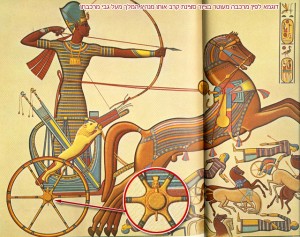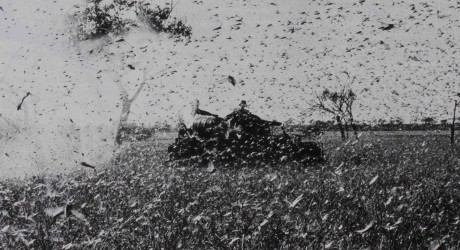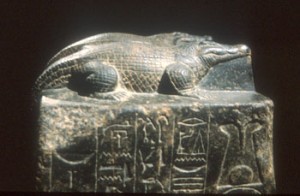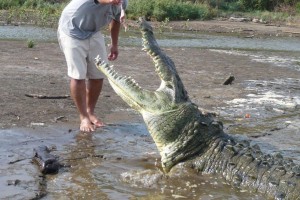The Haftarah talks about the miraculous defeat of the Canaanite general Sisra at the hands of Barak ben Avinoam. However, it does not describe it at all; in fact, it only hints at how it occurred. What went wrong for Sisra? How was it that 900 chariots failed to destroy Barak’s ragtag gang of farmers? What made Sisra’s camp panic and why did he have to run away on foot?
In past weeks, we have seen how understanding the Haftarah can give us insight into the Parsha. This time, it’s the other way around. Some of the information missing from the story of Barak’s victory over Sisra can be filled in by looking at similar text in Parshat Beshalach.
This is the text of the Haftarah, describing Sisra’s defeat:
יג) וַיַּזְעֵק סִיסְרָא אֶת כָּל רִכְבּוֹ תְּשַׁע מֵאוֹת רֶכֶב בַּרְזֶל וְאֶת כָּל הָעָם אֲשֶׁר אִתּוֹ מֵחֲרֹשֶׁת הַגּוֹיִם אֶל נַחַל קִישׁוֹן:
טו) וַיָּהָם ה’ אֶת סִיסְרָא וְאֶת כָּל הָרֶכֶב וְאֶת כָּל הַמַּחֲנֶה לְפִי חֶרֶב לִפְנֵי בָרָק וַיֵּרֶד סִיסְרָא מֵעַל הַמֶּרְכָּבָה וַיָּנָס בְּרַגְלָיו:
טז) וּבָרָק רָדַף אַחֲרֵי הָרֶכֶב וְאַחֲרֵי הַמַּחֲנֶה עַד חֲרֹשֶׁת הַגּוֹיִם וַיִּפֹּל כָּל מַחֲנֵה סִיסְרָא לְפִי חֶרֶב לֹא נִשְׁאַר עַד אֶחָד:
13) Sisra summoned his entire armored division, 900 iron chariots, and all the people that were with him, from Charoshet HaGoyim, to Nahal Kishon.
15) Hashem caused panic to Sisra, and all the chariots, and the entire camp, by the sword, before Barak; Sisra got down from his chariot and ran away on foot.
16) Barak chased the chariots and the camp, all the way to Charoshet HaGoyim;all of Sisra’s camp fell by the sword, not a one was left.
And this is the text of the Parsha, as it describes the defeat of Pharaoh at the Red Sea:
ז) וַיִּקַּח שֵׁשׁ מֵאוֹת רֶכֶב בָּחוּר וְכֹל רֶכֶב מִצְרָיִם וְשָׁלִשִׁם עַל כֻּלּוֹ:
כד) וַיְהִי בְּאַשְׁמֹרֶת הַבֹּקֶר וַיַּשְׁקֵף ה’ אֶל מַחֲנֵה מִצְרַיִם בְּעַמּוּד אֵשׁ וְעָנָן וַיָּהָם אֵת מַחֲנֵה מִצְרָיִם:
כה) וַיָּסַר אֵת אֹפַן מַרְכְּבֹתָיו וַיְנַהֲגֵהוּ בִּכְבֵדֻת וַיֹּאמֶר מִצְרַיִם אָנוּסָה מִפְּנֵי יִשְׂרָאֵל כִּי ה’ נִלְחָם לָהֶם בְּמִצְרָיִם:
כח) וַיָּשֻׁבוּ הַמַּיִם וַיְכַסּוּ אֶת הָרֶכֶב וְאֶת הַפָּרָשִׁים לְכֹל חֵיל פַּרְעֹה הַבָּאִים אַחֲרֵיהֶם בַּיָּם לֹא נִשְׁאַר בָּהֶם עַד אֶחָד:
7) Pharaoh took six hundred of his best chariots and all the cavalry and officers.
24) Toward morning, Hashem looked at Egypt’s camp with pillar of fire and cloud, He caused panic in Egypt’s camp.
25) He removed the wheels of the chariots, and drove it hard. Egypt said, “Let’s run away from Israel, for Hashem is fighting for them against Egypt.
28) The waters returned and covered the chariots and horsemen, all of Pharaoh’s army that were coming after them in the sea; not a one was left.
Repeated use of identical phrases in the Tanach is not coincidental, it is intentional. By making two texts parallel, the Tanach tells us that the two events they describe are parallel as well.
Consequently, we may ask the same questions about Pharaoh: how was it his 600 chariots failed to defeat a ragtag gang of slaves? What caused his army to panic? And how exactly does G-d “remove wheels of chariots”?
What we do know is that while the Jewish People crossed the sea on dry land, the same was not true for the Egyptians. As the pillar of cloud softened the ground, the chariots and horses churned it into mud. Anyone who has ever gotten their car stuck in muddy terrain will know that no matter how hard you rev the engine, the wheels only dig further in. The same is true for chariots, only worse: unlike most car engines, horses have feelings, and frustration makes them lash out. With horses kicking and screaming all around, the chariot becomes a trap for the people inside it. The only way out is on foot, while trying to dodge the hooves of the panicked horses.
The defeat of Sisra and his 900 chariots happened the same way. From the fact that he had to run away on foot, we know that his horses were unusable. The implication is that here too, the problem was muddy terrain.
In the Land of Israel, there is no rain from the months of April through September. Sisra would never have taken his chariots out if there were any risk of mud. We can thus infer that Barak drew him out to Har Tavor in early summer, in May or early June. Sisra must have seen this battle as golden opportunity to get rid of all Jewish resistance forever in one fell swoop while providing an excellent training exercise to his army of chariots.
One can only imagine what the men waiting on the top of Har Tavor felt, seeing this deadly force arraigned against them. Surely they were going to die…. Some suggest[1] the plan had been that while Sisra would be busy slaughtering them in the valley below Har Tavor, the forces of Ephraim would attack from the rear, and Zevulun from the west. But they would get slaughtered either way.
It is at this point that Hashem intervened. It happens very rarely, but it does happen, that there is a serious rainstorm in early summer, which causes instant flooding and terrible road conditions. A tiny swerve “from the stars in their paths” as Devorah called them, and Sisra’s army of chariots turned into a death trap. The reversal was total: the slaughter that Barak had anticipated did take place – but not of them, of their enemies. “Not a one was left.”
Similarly, in the Parsha, when the Jewish People were standing with their backs to the sea, with Pharaoh’s chariots bearing down on them, they surely felt that they were about to be slaughtered. There was no chance, no hope, of them surviving this battle. When Hashem intervened, and the chariots turned into death traps, the reversal was total: of their enemies, “not a one was left.”
The response of Moshe at the sea and Devorah at Har Tavor was identical as well: to compose a “Shira”, an epic poem, describing how their paralysis and fear turned to success and jubilation.
PDF for printing, 2 pages A4
Copyright © Kira Sirote
In memory of my father, Peter Rozenberg, z”l
לעילוי נשמת אבי מורי פנחס בן נתן נטע ז”ל





